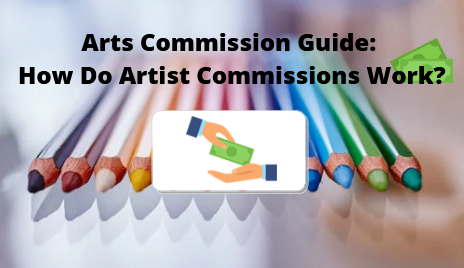8 TIPS FOR ARTISTS RECEIVE COMMISSION
Tips For Artists Receive Commission – As a self-employed artist, I rely more on commissions than selling my work in galleries. However, some artists are not great negotiators or business ideas, and art commissions that start with optimism can sometimes turn into a bitter feeling. These 8 tips will help you keep good clients, manage their expectations, and produce work with integrity.

1 – Time is the Key. Respond and Follow Your Tracks Quickly
If someone expresses interest in purchasing one of your items but cannot make a deposit or payment immediately, lower their contact details and follow up with them at the end of the day/event. Most people who buy art “don’t need it”. It is a luxury that is often bought without hesitation – they love art and should have it. But if you wait a long time, the impression may dissipate or overwhelm you. When art is intended as a gift, time is of the essence. I learned while working in advertising that no matter how well-marketed your product is if you do not sell at the right time, you are missing out. But fortunately, people are more willing to wait when it comes to art.
2 – Do Not Be Ashamed to State Your Goals
It is always wise to have an artist agreement signed by both parties to protect you from harm. First, the terms of the license must be specified. Does the client want the right to reproduce the artwork for sale/sale? They may think that ownership of a work is the same as having a license to reproduce it the way they see fit. It is your job to discover what that is and bring it about. Many artists retain their license rights for their work even after it has been sold. But an unsuspecting client may take your commission and reproduce it innocently in t-shirts or publish it for use in marketing without first notifying you. That will lead to an inevitable setback. Independent artists may request a “murder fee” – a liability in the event of a project being cancelled. Killing costs can be 50 – 100% of the project cost, depending on how soon the project will be cancelled.
3 – Request Payment In Advance
It is best to ask for 50% in advance to cover the cost of your items and time. Some people prefer 30% down and a few instalments. I would recommend taking between 30 – 50% upfront unless the commission belongs to a friend or someone with good standing with you. For larger commissions, consider a monthly payment plan in which you send your client monthly progress updates. Making a payment will help the sponsor and the artist stay invested in the piece and build a reliable working relationship.
4 – Know Exactly What You Are Being Asked To Do
Specify your definitions and interact with the client from time to time. Remember why the client chose you to start with it, and do not doubt your ability. TAKE a creative license – that’s why you’re hired! DO YOU start with ideas or drawings for approval before moving on to more expensive or larger projects. DO NOT come too often, or appear uncertain about yourself or your ideas, as this is an open invitation for your sponsor to promote their ideas or perhaps to drag you into a creative journey that is not yours. They are just trying to help, but they are probably doing the opposite.
5 – Inform You’re Promising Customers And Learn To Manage Difficult Ones
Not all commissions will go well, but don’t let a few bad experiences ruin much power. I had had my share of demanding clients, especially when I was a dedicated student and had just graduated from art school. This learning curve will capture information, but here are some clues you should be aware of. Good customers will insist on paying you in advance, leaving you a great art license, and giving you a broader spectrum to work with without interrupting your creative process. Stay with the right customers, as their confidence will inspire you to create more, which leads to more parts of the portfolio, and you will love what you do even more. The bad guys will try to tell you how to do things, change their minds after you start, or take control of your work a bit – but they insist that they are trying to help. Good client management skills and teaching your client about your process – just as you DON’T need them for smart installation – are essential to maintaining integrity in your work.
6 – Know Your Market
What kind of art do you like to create the most? What kind of art do you excel at? If you market yourself wisely, you will end up with the commissions you are most interested in. I have had trouble deciding for a long time because I enjoy creating in many styles – my work ranges from ordinary air springs and travel memories to bizarre dark images to colourful images. I would enjoy the pictures if I had to choose, but it takes a lot of time and has a fragile market compared to the world and the colourful pictures.
7 – Have a Way of Quoting Your Work
This will prevent panic when the opportunity arises. Many artists claim their work based on the average per project ($ = hours rated x hour per hour) or based on size ($ / sq footage), but those four variables should be kept in mind:
1) Time – Will you work on weekends or long hours? Or can you do this comfortably in a few hours? Should it be fast, or can you take your time?
2) Size – Larger pieces require additional paint, building materials, handling, shipping costs, etc.
3) Skill Required – Graphics and graphic design often require more skill than landscape, which has a higher value. Is the subject complex, such as lace or patterns that require a lot of detail?
4) Creative integrity. Will this clip improve your portfolio, or will you never show it off after it is finished? Is the project interesting, meaningful, and enjoyable to work on?
8 – Provide Good Information By Sharing Your Process
The more open and honest the client is, the more comfortable the feeling will be for both parties. Log in from time to time, and send them some pictures of ongoing work or an exciting review. I can’t stress enough excitement: YOU are an artist. If you sound happy with your piece, so does the client. If you feel insecure or insecure, your client will likely lose confidence in the project.
Markham artist Stacey MacNevin emphasizes the importance of not only bringing the painting but also bringing the whole experience. He advises, “Spend time ahead and listen to what the client wants from a piece of it. They may say: ‘I love your stuff – do whatever you want but no avail. ” Posting an artist should be fun, exciting, and rich with conversation and creativity. So take the time to understand your client, listen to their point of view, and give them insight into your creative process. It deserves a double whammy: the client will feel more connected to the piece because it is now more connected to your process.
While art commissions can sometimes be a test and a mistake, in my experience, these tips make customers happy and allow you to maintain your artistic integrity and creative vision.





buy augmentin 375mg pills – nizoral 200 mg for sale order cymbalta 40mg generic